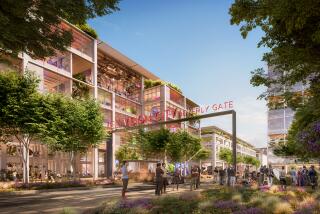DOWNTOWN : Lobbying Saves Bullock’s Store
- Share via
Thanks to a lobbying effort by officials of Rebuild L.A., the city and the Citicorp Plaza property manager, the Bullock’s department store at the Seventh Marketplace will not be closing after all.
Officials of R.H. Macy & Co. announced April 15 that they had reversed their March decision to close the Downtown store, one of eight Bullock’s and I. Magnin stores in California that the company planned to close as it reorganizes under Chapter 11 bankruptcy proceedings.
Macy’s officials said they were swayed by the economic support and promotions programs offered by Prudential Realty Group, property manager of Citicorp Plaza, and the campaign by city and community leaders.
“The ongoing effort to restore Los Angeles has been a remarkable endeavor . . . by the city of Los Angeles, Rebuild L.A. and community leaders. In the spirit of partnership the Macy organization wishes to work with these leaders,” Macy co-chairmen Myron E. Ullman III and Mark S. Handler said in a statement.
“We saved it at the last minute,” said Ed Avila, administrator of the Community Redevelopment Agency.
The 7-year-old Bullock’s is one of only three major department stores left Downtown and one of the Seventh Marketplace’s two anchor department stores. The shopping center at 7th and Figueroa streets was built as a city redevelopment project with Robinson-May as the other major store.
City officials see the 130-employee Bullock’s as an integral part of the redevelopment of the Figueroa Corridor, and its closure would have hurt the area and could have led to the flight of other stores, Avila said.
So Mayor Tom Bradley, Councilwoman Rita Walters and Rebuild L.A. officials joined Avila and the Prudential Realty Group in a letter-writing campaign to Macy’s. And Avila sent Don Spivack, the CRA’s director of operations, to accompany Prudential Realty representatives to New York about three weeks ago to talk to Macy officials.
Officials would not elaborate on the economic package Prudential offered to Macy’s. But Spivack said he spent more than five hours answering the company’s key question: “Why do we think anything will change Downtown?”
Spivack said he pointed out the Downtown’s many completed and nearly finished construction and transportation projects, including the Los Angeles Convention Center and Central Library expansions, and their potential to bring thousands of additional visitors and shoppers to the area.
City leaders also promised to work on marketing strategies that will link the Figueroa Corridor with other shopping areas Downtown, such as Little Tokyo and the garment district, Avila said.
“There is a burden on us as a city to help deliver more people there to shop and on them as a company to provide more merchandise people want to buy,” Spivack said.
More to Read
Inside the business of entertainment
The Wide Shot brings you news, analysis and insights on everything from streaming wars to production — and what it all means for the future.
You may occasionally receive promotional content from the Los Angeles Times.










